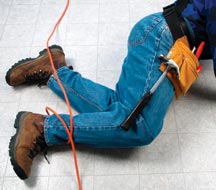
Moving from Injury to Exposure
Shifting our focus means changing how we engage employees.
- By Donald R. Groover, CIH, CSP
- Aug 27, 2007
 IN the first installment of this series, we
discussed the foundation of the injury-free
culture, creating alignment around
what we mean by “zero injury,” and establishing
true ownership for this vision. Once
we have created alignment and ownership,
what’s next? How does this new vision
change our approach to, and thinking
about, the basic mechanisms that drive
safety performance? Traditionally, injuries
have been the measure of performance and
the trigger for change. If our OSHA rate is
down, we say we’re doing well. If we have a
rash of injuries, we swing into action. In
terms of creating an injury-free culture,
however, this focus is highly flawed. It is
too imprecise and too reactive to be compatible
with a culture where we do everything
possible to prevent an injury.
IN the first installment of this series, we
discussed the foundation of the injury-free
culture, creating alignment around
what we mean by “zero injury,” and establishing
true ownership for this vision. Once
we have created alignment and ownership,
what’s next? How does this new vision
change our approach to, and thinking
about, the basic mechanisms that drive
safety performance? Traditionally, injuries
have been the measure of performance and
the trigger for change. If our OSHA rate is
down, we say we’re doing well. If we have a
rash of injuries, we swing into action. In
terms of creating an injury-free culture,
however, this focus is highly flawed. It is
too imprecise and too reactive to be compatible
with a culture where we do everything
possible to prevent an injury.
The next step in the injury-free culture,
then, is finding a new measure for success
and a new way of framing safety activities
and decisions. An injury-free culture
requires that we shift our focus to exposure.
An exposure focus means we are oriented
toward finding the potential for injury on
the shop floor and examining the systems,
procedures, and decision-making that influence
the quality and effectiveness of safety
systems. This article presents the case for
moving from injury to exposure as a measure
for safety activities and outcomes with
a discussion of the characteristics of this
thinking, its effect on decision-making, and
the pitfall that can prevent its effectiveness.
The Move from Injury to Exposure
As we have said, the injury-free culture is
concerned with doing everything possible to
prevent injuries and creating an ethos where
safety is the driving value.
From this perspective,
focusing on injuries and
injury rates has inherent
weaknesses. If you are
always chasing injuries,
you are caught in the trap
of looking in the rearview
mirror, focusing on
where you have been
rather than where you
want to go. This focus
also fosters inconsistencies
in leadership; it is
easy to take action when
there is blood on the
floor, but it’s harder to
take action when the
potential has not yet led to an event.
Focusing on exposure allows us to
examine and remedy potential for injuries
before they occur. It requires leaders to
take a long-term view of decisions, and it
forces us to think creatively about what
safety improvement really means. An
exposure focus is characterized by four
markers: taking action, shaping the safety
mechanism, engaging employees, and
leadership direction.
Taking action. The injury-free culture
uses exposure, not injury, as a trigger for
action. Ask yourself, what determines the
level of investigation here? In many cases,
the answer is the seriousness of injury,
which is often a result of luck. Organizations
serious about an injury-free culture
are thirsty for information about near misses
and first aid events. They use the
likely potential of an event to determine
the depth of the investigation. Similarly,
exposure-focused leaders determine
whether a site is making progress in safety
not on the injury rate, but on evidence that
it is reducing the probability of injury.
Shaping the safety mechanism. An
exposure focus also recognizes that not all
exposure represents the same level of
potential and designs systems for measurement
and control accordingly. One of the
worst things that can happen to an organization
is to achieve a very low injury rate,
then to have a serious injury or fatality
because the related exposure reduction systems
have become lax or have been eliminated
entirely. For the limited number of
exposures that can likely lead to a life-altering
injury or fatality, exposures need to
be well managed. They need mechanisms
in place to measure for variation and to
document the cause of the variation and
the actions taken. Leadership, in particular,
needs to keep a steady focus on high-potential events while moving the organization
to longer and longer periods of
injury-free experience. They do this by
routinely monitoring indicators related to
these exposures at the working interface or
measures related to their process safety
management systems.
Engaging employees. Shifting our focus
also means changing how we engage
employees. Exposure occurs at the working
interface, the junction where the employee,
the facilities and equipment, and procedures
come together. If a well-trained and
motivated employee meets with the proper,
well-maintained equipment, following a set
of current and accurate procedures, the
probability of injury is very low—not zero,
but low. Any misalignment in this configuration
increases exposure, resulting in a
higher probability of injury.
In order to engage employees either
formally through training or audits or
informally through conversations with
leaders, we need to develop an on-the ground
awareness of, and focus on, exposures.
For example, organizations often
attempt to engage employees by asking,
“In doing this job, do you believe you will
get injured?” For the most part,
employees who get hurt and the supervisors
who assign the jobs don’t anticipate
injury. A more useful question is, “Did
you notice an increase in exposure as you
were doing the work?”
Exposure and the leadership team. An
exposure-focus must be driven by leadership.
The higher in the organization one
goes, however, the harder it is for leaders to
see how their actions or inactions directly
contribute to exposure at the working
interface.
Consider some common leadership
decisions:
• To cut costs, an organization eliminates
all shift supervisors, leaving a day
foreman as the point of contact for the
shift employees.
• An operations vice president position
is filled by a leader from the plant
with the worst EHS performance but who
is known for “getting the product out.”
• A decision is made to stop
lockout/tagout verification audits by the
supervisors because they are too busy
with other paperwork and need to be in
their offices more.
• A senior leader decides not to communicate
the five-year plan, which will
include consolidation, plant closures,
and acquisitions, to the workforce.
Instead, employees will hear information
as it is released or leaked out.
These four scenarios are common organizational
events. They all also state explicitly
or implicitly what the organization
really values. Such decisions may not
increase exposure immediately, but given
enough time, they can strongly influence
the decisions, actions, and outcomes at the
working interface. The trap here is that in
spite of their influence, such decisions will
rarely be identified through a root cause
analysis as the pivotal or defining moment
in the path to an injury. That is why leaders
who hope to create injury-free cultures
must take a long-term view of their decisions’
influence on exposure.
Countering Attribution Bias
Finally, moving our focus from injury to
exposure requires an honest evaluation of
how we as individuals frame safety activities
and outcomes. Cognitive bias—mental
shortcuts we use to make judgments about
uncertainties—can skew our perceptions of
the exposures we are trying to remove.
Attribution bias, in particular, plays a role
in the unconscious process of determining
cause. It describes a tendency to associate
success with personal ability and failure
with bad luck or chance. This bias can lead
us to attribute internal causes of an incident
involving someone else (the cause resides
in the person—her behavior, lack or
training, or intelligence) or external factors
when I’m involved (the cause resides outside
myself, for instance in the systems,
equipment, or policies).
Consider an example where a mechanic
is critically injured while working on a
pump that is suddenly switched on by an
operator. A manager may say, “The
employee got injured because he didn’t
follow the procedure.” In other words, it
was caused by the employee’s poor attitude,
poor decision, or faulty belief system
(internal attribution). To the contrary, the
mechanic may say, “I got hurt because the
company didn’t give me the time to do the
job safely” (external attribution). In reality,
neither account is complete; exposure
occurs in the configuration of equipment,
systems, procedures, and the work being
done. Attribution bias can lead us to see
only one piece of a larger picture; in this
case, focusing only on the time pressures or
only on a deviation from procedure.
The truth is, these elements—with the
likely addition of other factors—exist
within a context that has a history. Singling
out one element to the exclusion of others
muddies our view of the context and
encourages blame, preventing us from getting
to the real issues. When we learn to
recognize attribution bias, develop appropriate
hazard recognition training, and
implement tools such as 5 Whys and ABC
Analysis in our investigations, we enable
individuals to dig deeper and draw a truer
picture of exposures.
Building on the Foundation
In this article, we have highlighted a focus
on exposure and the importance of overcoming
attribution bias. In future installments,
we will explore other factors that
build on this foundation; next will be metrics
and measures critical to injury-free
performance and, finally, the role of true
employee engagement for sustainability.
This article originally appeared in the September 2007 issue of Occupational Health & Safety.